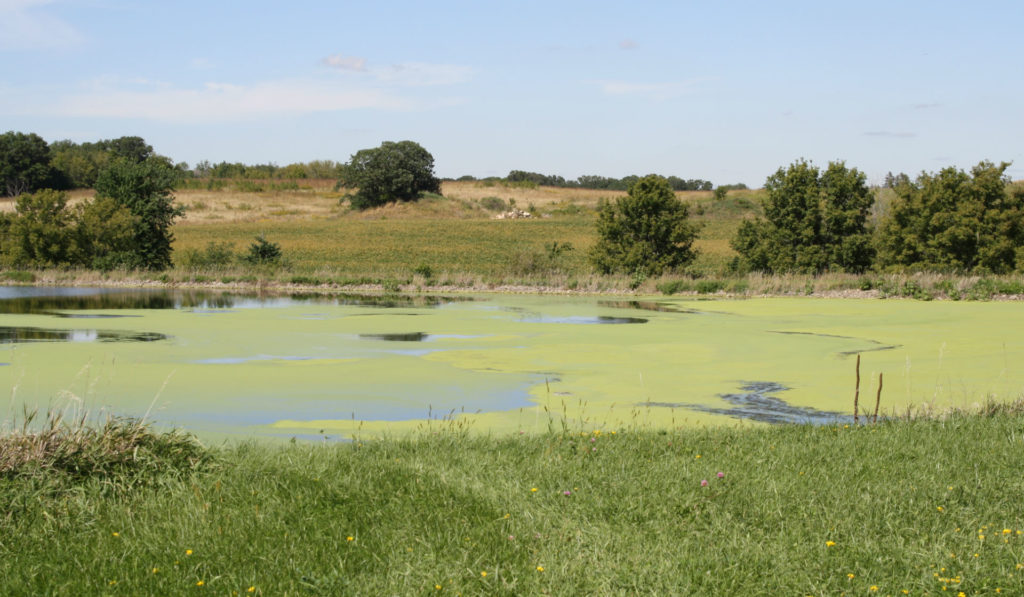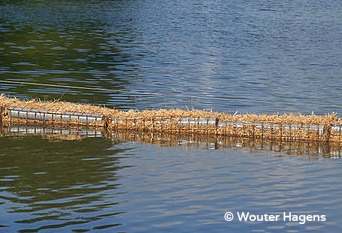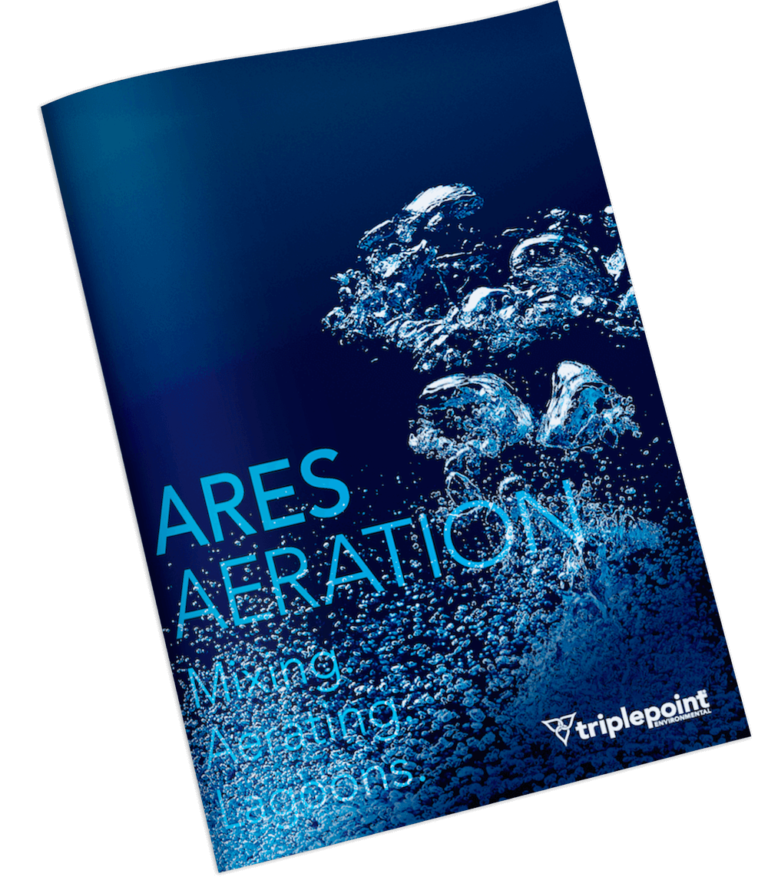
Summertime is boom time for algae due to the warm temperatures, abundant sunlight, and high nutrient loads. Excessive algal blooms in wastewater lagoons cause treatment deficiencies, so it’s a good time to look at some of the options for lagoon algae prevention and treatment.
Why is lagoon algae a problem?
Algal blooms in a wastewater lagoon, especially an aerated lagoon, provide little benefit and cause all sorts of problems:
High TSS and BOD5: High TSS, or total suspended solids, and high biological oxygen demand go hand in hand, as each mg of algal TSS results in about 0.5 mg of BOD. Most of the effluent TSS and BOD in the lagoon is caused by algae, and can actually result in levels higher than what came in. The problem with high TSS and BOD in effluent is the oxygen demand created in the receiving waterway.
Low oxygen: Algae create oxygen during the day and use it up at night, leaving less oxygen available for BOD-consuming bacteria to use. Sudden algal die-offs, either natural or caused by an additive, can also deplete oxygen and cause low dissolved oxygen (DO) conditions.
Nutrient feedback: Algae take up ammonia and phosphorus into their cells, and then release it back into the water column as they die off.
Odors: Low DO conditions contribute to odors, as do mats of decaying algae. Odors from algae tend to be pungent and earthy or grassy in nature.
Sludge: As algal blooms die off, they sink to the bottom and accumulate as sludge.
Options for lagoon algae prevention and treatment
Since algae interferes with efficient lagoon-based wastewater treatment and causes odors, it’s important to prevent it or at least keep it in check. Following are some popular methods for coping with lagoon algae.
Chemical additives: Chemicals like copper sulfate and chlorine are effective at killing algae, but they may also throw the whole food web out of balance and inhibit bacteria’s ability to consume BOD. Some additives, like copper, can accumulate and make sludge disposal more difficult. Regulatory bodies may require a permit for the use of additives to protect fish and other life in the receiving stream.

Barley straw: Bales of barley straw can be placed in a wastewater lagoon to inhibit algae; as they rot, the organic chemicals that are released inhibit algal growth. The scientific paper Inhibitory Effect of Decomposing Barley Straw on Algal Growth in Water and Wastewater states that “good aeration, neutral to alkaline pH, and open sunlit water are essential for optimum algal control by barley straw.”
Barley straw does not treat existing algae, only prevents it, so it will need to be installed in the spring, before water temperatures begin to rise. Barley straw bales will need to be replaced every month or two. Another possible issue with barley straw is that once it breaks down and falls into a lagoon, it will add to your BOD loading and your sludge blanket.
Raking or screening: Mechanical removal of algae is labor intensive and unlikely to be an effective ongoing strategy.
Retention time: According to the late Linvil Rich, the founder of Clemson University’s Department of Environmental Engineering and Science and a pioneer in lagoon technology, hydraulic retention time [HRT] is the most influential factor in controlling the growth of algae. The shorter the retention time, the less opportunity for algae to grow. However, while shorter retention times prevent algae, sufficient HRT is critical to the treatment of BOD and pathogens.
Baffling: Adding baffles to subdivide a lagoon into smaller cells prevents short-circuiting, or wastewater traveling along thermoclines and emerging undertreated. It also allows you to discharge from the cell with the best water quality. For more about short-circuiting, see our article, How to Prevent Wastewater Lagoon Short Circuit.

Shading: Because algae is reliant on sunlight to grow, anything natural or artificial that blocks light from entering the water will prevent it. Floating insulated covers like our AlgaeProtect can be used to cover all or part of the surface. Additive dyes can also be effective in blocking out sunlight, although some regulators prohibit the discharge of dye into the environment.

Duckweed can effectively prevent algal growth by covering the lagoon’s surface, but causes problems on its own. Read our article, Lagoon Duckweed: Friend or Foe? for more about the pros and cons of duckweed in a wastewater lagoon. Any cover over the surface will disrupt the transfer of oxygen into the water, so it will be necessary to provide supplemental aeration to keep the lagoon from going septic.
Controlled discharge: This is one of the least expensive ways to keep algal cells from being discharged in effluent. Discharge from the cell having the best water quality, and draw from a few inches below the photic zone, where there are fewer algal cells. Algae moves through the water column vertically in response to light penetration, so discharging at night would likely provide higher effluent quality than in the afternoon. Controlled discharge, however, requires the storage of wastewater during the times you are not discharging and therefore requires additional storage capacity.
Filtration: Intermittent sand filtration, while primarily used for nitrification, can also remove algae. However, as lagoon expert Linvil Rich stated in his technical note about algae control, what do you do with the backwash water? Recycling it back to the lagoon will just cause more algae to accumulate, requiring more frequent cycles.
Ultrasound: This technology relies on sonic waves to inhibit the growth of algae, and can be programmed to address the specific type of algae that’s present. These devices are environmentally friendly, having no effect on fish, plants, insects, or other lifeforms, and requiring very little power to run. Ultrasound has proven effective in controlling algae in lakes and drinking water reservoirs, and the technology seems promising for a wastewater lagoon application.
Aeration and Mixing: Adding mechanical aeration and mixing to a lagoon prevents algae in a number of ways. The turbulent action on the surface of the water blocks the sunlight penetration that fuels algae growth, and helps to off-gas excess CO2. Mixing throughout the water column reduces retention time, keeping slower growing algae from gaining a foothold.
Lagoon Algae Prevention Beats Lagoon Algae Treatment
The presence of algal blooms is both an indicator of poor treatment conditions, such as high levels of nutrients like ammonia and phosphorus, and a contributor to poor effluent quality, due to increased BOD and TSS.
Rather than have to contend with the labor and expense of removing algae, it’s better to prevent it in the first place by properly aerating and mixing the lagoon.
- Improve Aeration—A properly aerated lagoon should only experience minimal algae growth around its edges during the hottest summer months. If your existing aeration system is not functioning properly, with aerators or blowers out of service, fixing them is a necessity. Or, if your aeration system is in need of an upgrade, you may want to consider lagoon aeration alternatives.
- Increase Lagoon Mixing & Water Turbulence—The natural habitat for algae is at the surface of the water. If you disrupt that habitat, you also disrupt the algae growth in your wastewater lagoon. Different lagoon aeration systems will create differing amounts of turbulence. Fine bubble systems create a mild turbulence at the surface of the water, while coarse bubble systems are perhaps the best, as the large bubbles create vigorous turbulence. Surface aeration creates a tremendous amount of turbulence where the actual aerator is located. However, often that mixing energy is not as well distributed throughout the lagoon as compared to a fine or coarse bubble diffused system, or our Ares Aerator®, which combines a coarse bubble static tube and fine bubble diffusers in a single, portable unit. Either way, the more turbulence in the water, the better your chances are of preventing lagoon algae.
Download the Ares Aeration brochure.
Triplepoint’s Ares Aeration® System can help prevent lagoon algae by increasing mixing and turbulence while boosting treatment.

